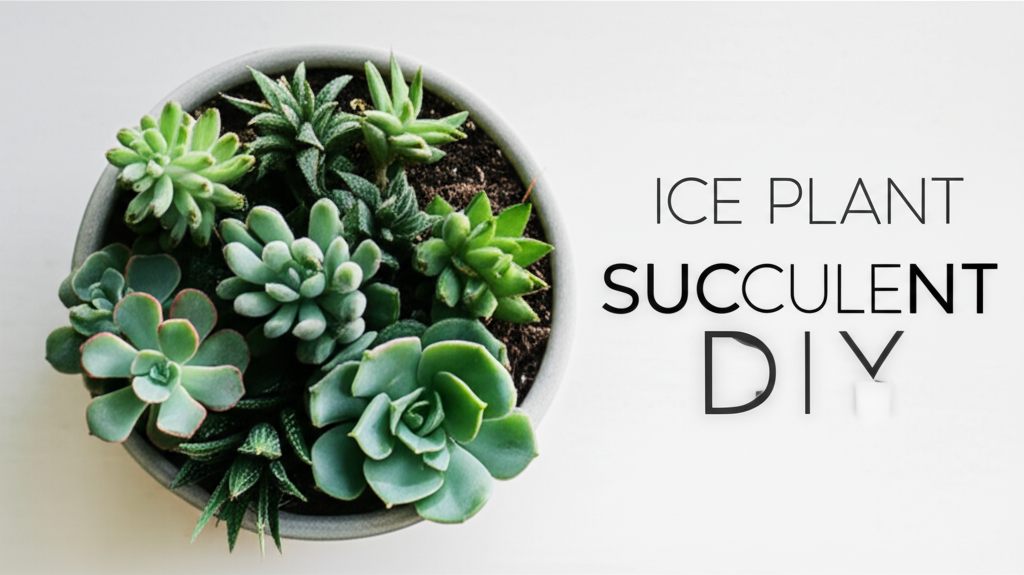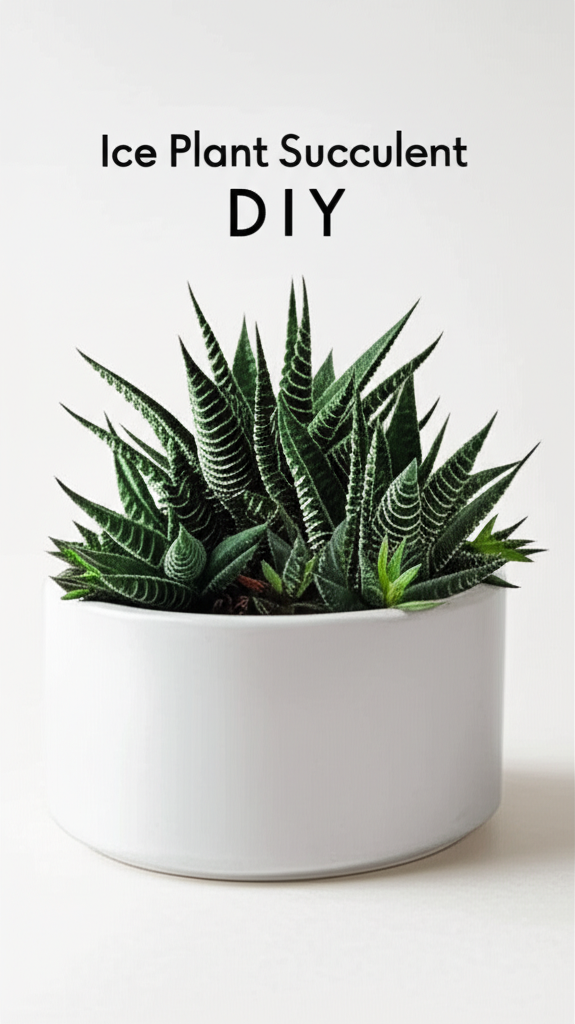Introduction: Bringing the Desert Bloom Indoors
The allure of succulents is undeniable. Their sculptural forms, diverse textures, and forgiving nature make them perfect for indoor cultivation. Among the vast succulent family, the Ice Plant (family Aizoaceae, encompassing genera like Delosperma, Mesembryanthemum, and Lampranthus) stands out with its vibrant, often iridescent flowers that resemble ice crystals catching the sun. Creating a DIY indoor table garden featuring these captivating plants offers a unique opportunity to inject color, texture, and a touch of the arid landscape into your living space. This guide will walk you through everything you need to know to design, build, and maintain a stunning ice plant succulent table garden, transforming a simple surface into a miniature botanical masterpiece.
Understanding Ice Plants: More Than Just Pretty Faces

Before diving into the DIY process, it’s essential to understand what makes ice plants so special and how to cater to their specific needs. Ice plants are characterized by their succulent leaves, which often have specialized epidermal cells called “papillae” or “vesicles.” These translucent, watery cells can give the plant a glistening, icy appearance, especially in sunlight. This adaptation helps them reflect excess sunlight and capture moisture from the air.
Key Characteristics of Ice Plants:
- Appearance: Typically low-growing, spreading, or sometimes shrub-like. Leaves are often fleshy, cylindrical, or triangular, with a glistening surface due to specialized cells.
- Flowers: The most striking feature. Ice plants are renowned for their profusion of daisy-like flowers, which bloom in a dazzling array of colors including vibrant pinks, purples, reds, oranges, yellows, and whites. Many varieties exhibit a unique iridescence.
- Sunlight Needs: Most ice plants thrive in full sun to partial shade. Indoors, this translates to the brightest windowsill or a location with at least 6 hours of direct sunlight per day.
- Watering: As succulents, they are drought-tolerant. Overwatering is their biggest enemy. Allow the soil to dry out completely between waterings.
- Soil: They require well-draining soil to prevent root rot. A cactus or succulent mix is ideal, or you can create your own.
- Temperature: Generally prefer warm temperatures, but many varieties are surprisingly frost-tolerant in their native habitats. Indoors, they do well in average room temperatures.
Popular Ice Plant Genera for Indoor Gardens:
- Delosperma: Known for its hardiness and vibrant, often long-lasting flowers. ‘Cooper’s Ice Plant’ (Delosperma cooperi) is a popular choice with bright purple-pink flowers.
- Mesembryanthemum: Includes species with striking flower colors. Mesembryanthemum crystallinum (Common Ice Plant) is known for its glistening leaves, though its flowers are less showy than other types.
- Lampranthus: Often produces masses of flowers in intense colors, giving a spectacular display. Varieties like Lampranthus spectabilis are highly ornamental.
Designing Your Ice Plant Succulent Table Garden: A Creative Canvas
The beauty of a DIY table garden lies in its personalization. You’re not just planting; you’re creating a miniature landscape. Consider the size of your table, the natural light available, and the aesthetic you wish to achieve.
Table Garden Concepts:
- Monochromatic Majesty: Focus on ice plants with flowers in a single color spectrum for a sophisticated, unified look.
- Rainbow Radiance: Combine ice plants with a variety of bloom colors for a vibrant, joyful display.
- Textural Tapestry: Mix ice plants with other succulents that offer contrasting leaf shapes and textures, such as Echeverias, Sedums, or Haworthias.
- Minimalist Marvel: Select a few striking ice plants and a simple, elegant container for a clean, modern aesthetic.
Choosing Your Container: The Foundation of Your Garden
The container is more than just a pot; it’s the stage for your succulent display.
Container Considerations:
- Drainage: This is paramount! The container MUST have drainage holes. If using a decorative pot without holes, ensure you have an inner pot with drainage that fits snugly, and a system to catch excess water.
- Material: Terracotta, ceramic, concrete, or even weathered wood can work. Terracotta is porous and helps with aeration and drying, which is beneficial for succulents.
- Size and Depth: Consider the mature size of your chosen ice plants and how many you plan to include. A wider, shallower container is often preferable for showcasing spreading ice plants and allowing for better air circulation.
- Style: Match the container to your interior décor. A rustic wooden trough, a modern concrete planter, or a vintage ceramic bowl can all be beautiful choices.
Building Your Ice Plant Succulent Table Garden: Step-by-Step
Once you have your vision and materials, it’s time to get your hands dirty.
Gather Your Materials:
- Chosen container(s)
- Ice plant succulents (various varieties for interest)
- Well-draining potting mix (cactus/succulent blend)
- Coarse sand or perlite (for improved drainage)
- Small pebbles or gravel (for top dressing and drainage layer)
- Gloves (optional, some succulents have fine hairs)
- Trowel or small spade
- Watering can with a fine spout
- Decorative elements (optional: small rocks, polished stones, miniature figurines)
Step-by-Step Construction:
- Prepare the Container: Ensure your container is clean and has adequate drainage holes. If using a decorative outer pot, place a layer of gravel or broken pottery shards at the bottom to facilitate drainage.
- Add Potting Mix: Fill the container about two-thirds full with your well-draining potting mix. You can amend the mix with extra perlite or coarse sand to further enhance drainage if needed.
- Arrange Your Plants: Before planting, arrange your ice plants on the surface of the soil to visualize your design. Consider their mature growth habits – place taller or more upright varieties towards the back or center, and trailing types near the edges.
- Planting: Gently remove each ice plant from its nursery pot. Loosen any compacted roots. Dig small holes in the soil and place each plant, ensuring the base of the plant is at soil level. Fill in around the roots with potting mix, gently firming the soil. Leave about an inch of space from the rim of the container for watering.
- Add Top Dressing (Optional but Recommended): Cover the exposed soil surface with a layer of small pebbles, gravel, or decorative sand. This not only looks aesthetically pleasing but also helps retain soil moisture, suppress weeds, and prevent the lower leaves from sitting in wet soil.
- Initial Watering: Wait at least a day or two after planting before watering. This allows any damaged roots to callous over, reducing the risk of rot. When you do water, water thoroughly until water drains from the bottom.
- Placement: Position your newly created table garden in a location that receives ample sunlight.
Caring for Your Indoor Ice Plant Table Garden: Nurturing the Bloom
Consistent, appropriate care is key to a thriving ice plant table garden.
Watering: The Delicate Balance
The most critical aspect of succulent care is watering.
Watering Schedule and Techniques:
- When to Water: Water only when the soil is completely dry. You can test this by sticking your finger about an inch into the soil. If it feels dry, it’s time to water.
- How to Water: Water deeply, allowing water to run through the drainage holes. Avoid misting the leaves, as this can encourage fungal diseases.
- Frequency: This will vary depending on your environment (light, temperature, humidity). In general, during the growing season (spring/summer), you might water every 2-4 weeks. In winter, when growth slows, watering can be reduced to once a month or even less.
- Signs of Underwatering: Wrinkled or deflated-looking leaves.
- Signs of Overwatering: Yellowing, mushy leaves, especially at the base, and potential root rot.
Sunlight: The Driving Force
Ice plants need plenty of light to produce their spectacular blooms.
Sunlight Requirements:
- Indoors: Aim for the brightest windowsill available, ideally south or west-facing. If natural light is insufficient, consider supplementing with grow lights.
- Rotation: Rotate your table garden periodically to ensure all sides receive even light exposure, promoting balanced growth.
- Signs of Insufficient Light: Leggy growth (stretching between leaves), pale coloration, and lack of flowering.
Soil and Fertilization: Providing the Nutrients
Using the right soil and occasional feeding will keep your ice plants healthy.
Soil and Feeding Guidelines:
- Soil: As mentioned, well-draining cactus or succulent mix is essential. Avoid heavy, moisture-retentive soils.
- Fertilization: Ice plants are not heavy feeders. During the growing season (spring and summer), you can feed them with a diluted, balanced liquid fertilizer formulated for succulents or cacti, typically once a month. Do not fertilize during the dormant winter months.
Pruning and Maintenance: Keeping it Tidy
Regular maintenance will keep your table garden looking its best.
Pruning and Upkeep:
- Deadheading: Remove spent flowers to encourage more blooms and keep the plant looking tidy.
- Trimming: If plants become leggy or overgrown, you can prune them back to encourage bushier growth. The cuttings can often be propagated into new plants.
- Pest Control: Inspect your plants regularly for common succulent pests like mealybugs or spider mites. Treat any infestations promptly with insecticidal soap or neem oil.
Troubleshooting Common Issues
Even with the best care, occasional problems can arise.
Common Problems and Solutions:
- Leaf Drop: Can be caused by overwatering, underwatering, or extreme temperature fluctuations. Assess your watering habits and environment.
- Lack of Flowers: Usually due to insufficient sunlight. Relocate the plant to a brighter spot or supplement with grow lights.
- Root Rot: The most common killer of succulents. Caused by overwatering and poor drainage. If caught early, you may be able to save the plant by repotting it in dry, well-draining soil after removing any rotten roots.
Key Facts & Comparison Table
To summarize the essential elements for your ice plant table garden, here’s a helpful comparison.
| Aspect | Ideal Conditions | Common Mistakes | Signs of Distress |
|---|---|---|---|
| Sunlight | Full sun to bright indirect light (6+ hours daily) | Too much shade, not enough light | Leggy growth, pale color, no flowers |
| Watering | Allow soil to dry completely between waterings | Overwatering, infrequent deep watering | Yellow/mushy leaves, root rot |
| Soil | Well-draining cactus/succulent mix | Heavy, moisture-retentive soil | Waterlogged roots, fungal issues |
| Temperature | Average room temperatures (65-80°F / 18-27°C) | Extreme temperature fluctuations, drafts | Leaf drop, stress |
| Container | With drainage holes | No drainage, pots too small | Root rot, stunted growth |
Pros and Cons of Ice Plant Succulent Table Gardens
As with any gardening endeavor, there are advantages and disadvantages to consider.
| Pros | Cons |
|---|---|
| Aesthetic Appeal: Vibrant, jewel-toned flowers and unique leaf textures. | Light Dependency: Requires significant bright light, which might be challenging in some homes. |
| Low Maintenance: Once established, they are relatively easy to care for. | Overwatering Risk: Susceptible to root rot if not watered correctly. |
| Drought Tolerant: Can withstand periods of dryness, making them forgiving for forgetful waterers (within reason). | Slow Growth: Some varieties grow slowly, so don’t expect rapid transformations. |
| Air Purification: Like other houseplants, they contribute to better indoor air quality. | Pest Susceptibility: Can attract common houseplant pests if conditions are not optimal. |
| Customizable: Can be tailored to your personal style and available space. | Seasonal Blooms: Flowering is often seasonal, so the visual impact can vary throughout the year. |
Conclusion: Your Miniature Oasis Awaits
Creating an indoor ice plant succulent table garden is a rewarding project that brings a touch of natural artistry into your home. By understanding the unique needs of these remarkable plants and following these simple guidelines, you can cultivate a vibrant, captivating display that provides beauty and a sense of accomplishment. Experiment with different containers, plant combinations, and decorative elements to make your table garden truly your own. With a little sunshine and mindful watering, your ice plants will reward you with their dazzling blooms, transforming your tabletop into a miniature oasis of color and life. Happy gardening!


